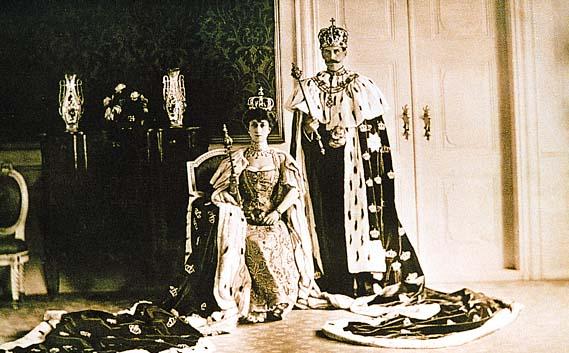 |
| The marriage of Prince Carl of Denmark and Princess Maud of Wales by Laurits Tuxen. Source: Wikipedia |
On July 22, 1896, Prince Carl of Denmark (soon to be King
Haakon VII of Norway) and Princess Maud of Wales were married at the Private
Chapel of Buckingham Palace, London.
The bride and groom were first cousins. Prince Carl, the
second son of then-Crown Prince Frederick of Denmark and Princess Louise of
Sweden, was born at the Charlottenlund Palace on August 3, 1872 and was
christened Christian Frederik Carl Georg Valdemar Axel. Maud, meanwhile, was
the youngest daughter of Albert Edward, Prince of Wales (later King Edward VII)
and Princess Alexandra of Denmark. Both Frederick and Alexandra were children
of King Christian IX of Denmark.
At a young age, Carl was not expected to become king because he was a second son. So, he built a career in the military, where he served as a naval officer at the Royal Danish Naval Academy in Copenhagen. Maud, meanwhile, was the liveliest of Edward and Alexandra's three daughters. She fell in love with Prince Francis of Teck, the younger brother of her sister-in-law, the future Queen Mary. However, it became apparent that Francis was not interested of her, and so, no romance developed between the two.
As cousins, Maud and Carl often met, especially during
family gatherings. Rumours eventually circulated within the family that the two
might get married. Carl proposed during a reunion at Fredensborg
Castle and Maud accepted. Their engagement was announced on October 29, 1895. Princess
Alexandra was initially hesitant of the engagement because Maud was a few years
older than Carl. She only relented when she realized that Carl would prove to be
the right husband for her sea-loving daughter.
 |
| King Haakon VII and Queen Mary during their coronation. Image: Wikipedia |
The engagement delighted Queen Victoria. According to Marie Mallet, Queen Victoria's Maid of Honour, news of their engagement “…caused much excitement at Balmoral…and has been the cause of much telegraphing…The Queen is delighted and healths were drunk at dinner.”
The wedding was set on July 22, 1896. The wedding
was almost delayed after Prince Henry of Battenberg's untimely death, but it was
finally decided that the wedding should go on as scheduled and that Princess
Beatrice and her children would not attend.
European royals converged in London for
this wedding. Members of both the British and Danish royal families were
present, as well as their Greek, German, Russian, and Swedish relatives. The bride wore a simple dress fashioned by Miss Rosalie
Whyte of the Royal Female School of Art. It had a long train and was made of pure
white English satin which was woven in Spitalfields, a section of London
known for its weaving. She wore the Princess of Wales' wedding veil and instead
of a tiara, she adored her hair with flowers.
The wedding was described as sunny and pleasant and it was
treated more of a family gathering rather than a grand state occasion. Queen
Victoria, who did not join the public procession, immediately retreated back to
Buckingham Palace after the ceremony.
 |
| The Norwegian Royal Family: King Haakon VII, Queen Maud and Crown Prince Olav (seated in the middle). Image: Wikipedia |
Two luncheons were held at Buckingham Palace: the royals dined at the State Dining Room, while the rest of the wedding guests were hosted at the State Ballroom. The newly weds, together with the Prince and Princess of Wales, then greeted guests at the Picture Gallery. A garden party was also hosted by the Prince and Princess of Wales at Marlborough House that afternoon.
At 2:45 PM, the bridal party left Buckingham Palace for
Sandringham. En route to the train station, the royal couple passed through cheering
people. They honeymooned at Appleton House, the country home at Sandringham which was given to them as a wedding gift by the bride's parents. What seemed to be a
honeymoon of only a few weeks lasted for five months, mainly due to Maud’s
reluctance to move in Denmark. However, as Prince Carl had to return to his
stint in the navy it was a must that they head to Denmark, and so they did on
December 21, 1896. Maud, on her part, couldn’t bear the bitter Danish winters
and also visited England as often as she could.
In 1905, the Union between Sweden and Norway was dissolved and the new government went in search for a new king for Norway. Carl became a strong candidate, primarily because he can claim descent from prior Norwegian monarchs. Maud’s British connections also made him even more desirable. Democratically-minded, Carl, remarked that he would accept the offer on the condition that a referendum be held to determine if the Norwegians were really in favour of a monarchy. The referendum resulted to an overwhelming majority in favour of monarchy. Prince Carl was officially offered the throne, which he accepted. Carl, Maud and their only child, Alexander (born in 1903), arrived in Norway on November 25, 1905. He took the oath as King two days later, taking the name of King Haakon VII. Meanwhile Maud became Queen of Norway. Prince Alexander, who was now Crown Prince of Norway, took on the name Olav.

.png)





1 Comments
Are you paying over $5 / pack of cigs? I'm buying my cigs over at Duty Free Depot and I save over 50%.
ReplyDelete